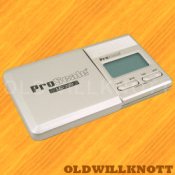Wikipedia is your friend!
 http://en.wikipedia.org/wiki/Potassium_dichromate
http://en.wikipedia.org/wiki/Potassium_dichromate
From Wikipedia: Density = 2.676 g/cm3, solid.
Therefore, one gram would be approximately 0.37 ml. ( 1 ÷ 2.676 = 0.37369208 )
This assumes that the crystals are small and uniform in size. You still won't get a very reliable measurement.
The best thing to do is get a good laboratory balance, not a "scale."
A kitchen scale is designed to measure weights in the range of a few hundred grams to a few kilograms. That's between 100 and 1,000 times larger than you are trying to measure. A kitchen scale probably won't measure anything less than 10 or 20 grams with any kind of accuracy. Furthermore, it resolve to 0.5 grams. Even then, expect only ± 1 gram of precision. When you are cooking, you don't need accuracy/precision to 0.01 gram. Why should a cook spend the money for something that will?
All that aside, you MIGHT have better luck if you put some other weight on the scale along with the item you are trying to measure. That will bring the scale into its most accurate range.
Stack a handful of coins on the scale so that it reads, maybe, 50 or 100 grams then press the "tare" button. You will set the display to zero and the scale will remember the offset. Be sure to include your petri dish or other measurement container in the tare reading.
Even with all that, you'll be lucky to get within a gram of the true weight/mass of the thing you want to measure.












